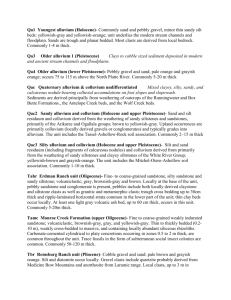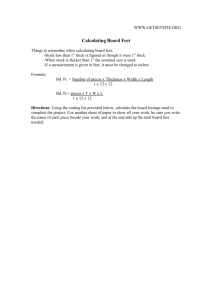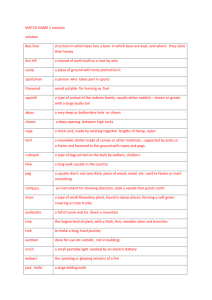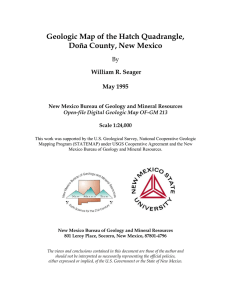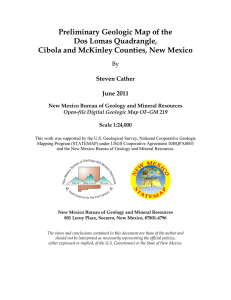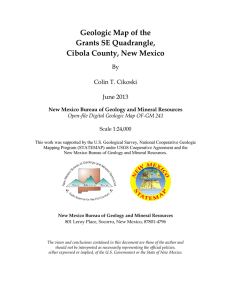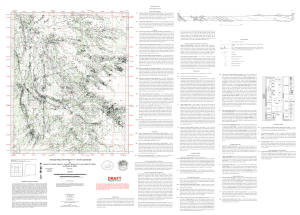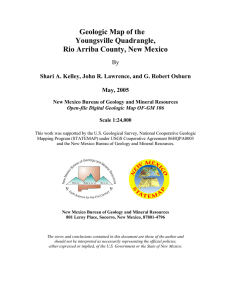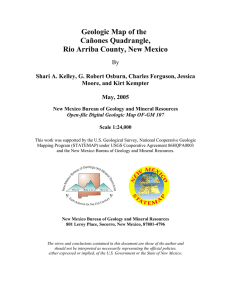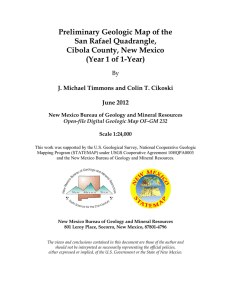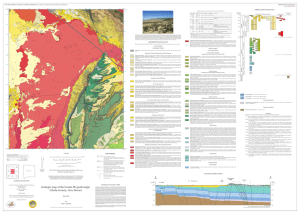Geologic Map of the Engle Quadrangle, Sierra County, New Mexico By
advertisement
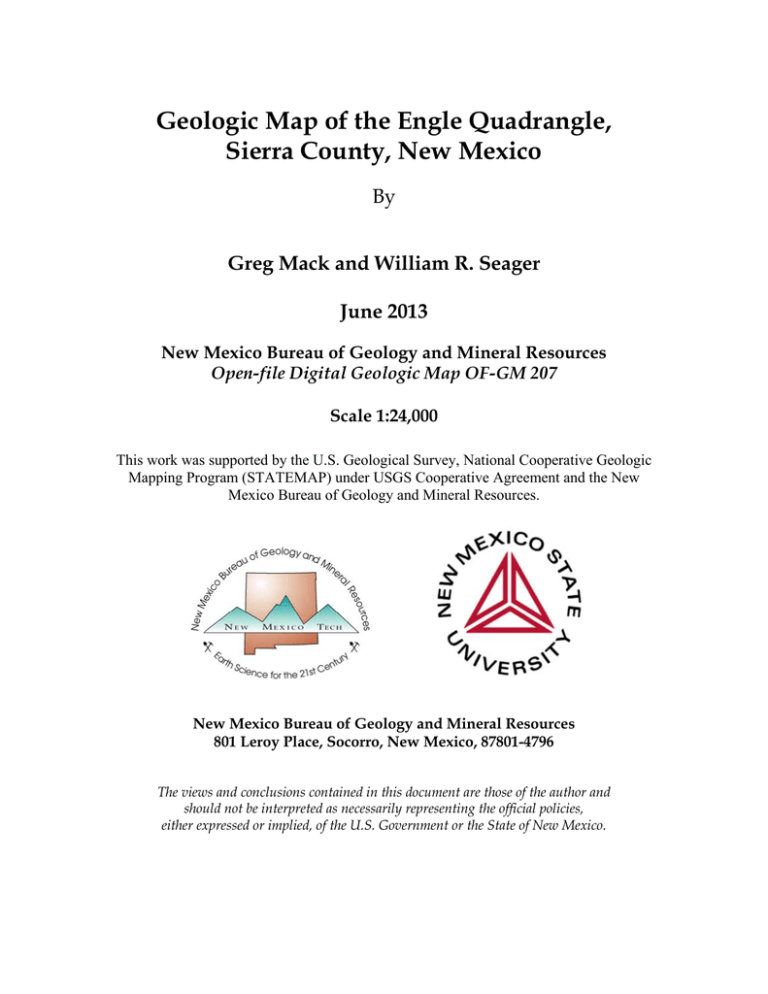
Geologic Map of the Engle Quadrangle, Sierra County, New Mexico By Greg Mack and William R. Seager June 2013 New Mexico Bureau of Geology and Mineral Resources Open-file Digital Geologic Map OF-GM 207 Scale 1:24,000 This work was supported by the U.S. Geological Survey, National Cooperative Geologic Mapping Program (STATEMAP) under USGS Cooperative Agreement and the New Mexico Bureau of Geology and Mineral Resources. New Mexico Bureau of Geology and Mineral Resources 801 Leroy Place, Socorro, New Mexico, 87801-4796 The views and conclusions contained in this document are those of the author and should not be interpreted as necessarily representing the official policies, either expressed or implied, of the U.S. Government or the State of New Mexico. Engle Unit Descriptions Quaternary Younger valley-fill alluvium—Sand and gravelly sand deposits of arroyos, alluvial fans, and terraces, whose surfaces are graded to within a few feet (meters) of the modern Rio Grande floodplain. As much as 10ft (3m) thick. Older valley-fill alluvium—Sand, gravel and sandy gravel deposits of arroyos, fans, terraces and erosion-surface veneers, whose surfaces are graded to as much as 150ft (46m) above the Rio Grande floodplain. Pedogenic carbonate typically is well developed (stage II - III) in the upper parts of the deposits. As much as 25ft (8m) thick. Undifferentiated Qvo and Qvy Eolian alluvium—Sand and loamy sand ridges, dunes, and mounds that accumulated in the lee of playa lakes. As much as 35ft (10m) thick. Playa lake deposits—Silt and clay on the floors of playa lakes. Probably 3 to 10ft (1 to 3m) thick. Younger piedmont-slope alluvium—Sand, gravel and silt of shallow drainageways, alluvial fans, and erosion surface veneers that is inset below or overlies older (Qpo) deposits. As much as 10ft (3m) thick. Older piedmont-slope alluvium—Sand, gravel, silt and silty clay of alluvial fans, erosion surface veneers and basin floors that is inset below or overlies the Cuchillo surface. Stage II-III soil carbonate is typically well developed in the upper part of the deposits. As much as 25ft (8m) thick. Undifferentiated Qpy and Qpo Palomas Formation, upper part—Brown to reddish brown conglomerate and gravel, consisting largely of cobbles and pebbles of Paleozoic limestone, Abo Sandstone, second-cycle clasts from Cretaceous formations, and basalt. Also locally contains discontinuous beds of crossbedded sand or sandstone. Unit is remnant of thin, widespread alluvial fans and pediment veneers derived mainly from the Fra Cristobal range and, on the east edge of the map, from the San Andres Mountains. Stage IV pedogenic carbonate marks the upper part of the unit, directly beneath the Cuchillo surface. As much as 20ft (6m) thick. Tertiary Basalt—Flows and cinder cones of black to dark gray vesicular to scoriaceous basalt locally containing abundant mantle and crustal xenoliths. As much as 100ft (30m) thick. Palomas Formation, lower part—Tan sandstone and pebbly sandstone containing angular clasts derived from the McRae and Crevasse Canyon Formations. Crossbedding and cut and fill structures are common within the unit as are multiple paleosols. Stage IV pedogenic carbonate is present at the top of the unit, beneath basalt flows (Tb). Zero to 60ft (18m) thick, thickening westward. Palm Park Formation—Pale purple-gray lahar breccia containing clasts of intermediate-composition volcanic rocks; exposed only along the road east of Engle and in a barrow pit south of Engle. A thickness of 5ft (1.5m) is exposed. Love Ranch Formation—Basal boulder conglomerate consisting of intermediate composition porphyries overlain by red siltstone and mudstone containing conglomerate beds with abundant Abo, as well as intermediate-composition volcanic clasts. Approximate thickness may be 500ft (152m). Cretaceous McRae Formation, Hall Lake Member—Conspicuous purple shale containing interbedded lenticular pebbly, lithofeldspathic, crossbedded sandstone and, in the lower part, pebble-cobble conglomerate. Clasts include Precambrian granite and quartzite as well as intermediate-composition porphyrys. Local zones of calcic nodules are paleosols. Dinosaur bones and petrified wood are present. At least 770ft (234m) thick. McRae Formation, Jose Creek Member—Interbedded olive gray shale, brown, crossbedded, lithofeldspathic, pebbly sandstone and thin, well-indurated volcanic ash beds. Near the top are one or more purple bedded chert units as much as 1ft (0. 3m) thick. Pebble and cobble clasts are intermediate-composition porphyries. Dinosaur bones, plant fossils, and petrified wood are present. As much as 558ft (170m) thick. Crevasse Canyon Formation, Ash Canyon Member—Predominantly tan, mediumgrained, cross-bedded lithofeldspathic sandstone interbedded with lesser amounts of olive gray mudstone. Chert pebble conglomerate lenses within sandstone beds are present locally, especially near the top of the unit. Local petrified wood. Approximately 1,200ft (365m) thick. Crevasse Canyon Formation—Brown to tan to greenish-brown, fine- to mediumgrained, lithofeldspathic sandstone in channel shaped and lenticular beds, intercalated with olive-gray shale and mudstone. At least 830ft (153m) thick. Gallup Sandstone and D-Cross Member of Mancos Shale, undifferentiated—Tan, massive sandstone containing thin beds of pelecypod coquina and gray, fissile marine shale. Base not exposed. At least 100ft (30m) thick. Mesozoic-Paleozoic, undifferentiated—Cross-sections only. 2
